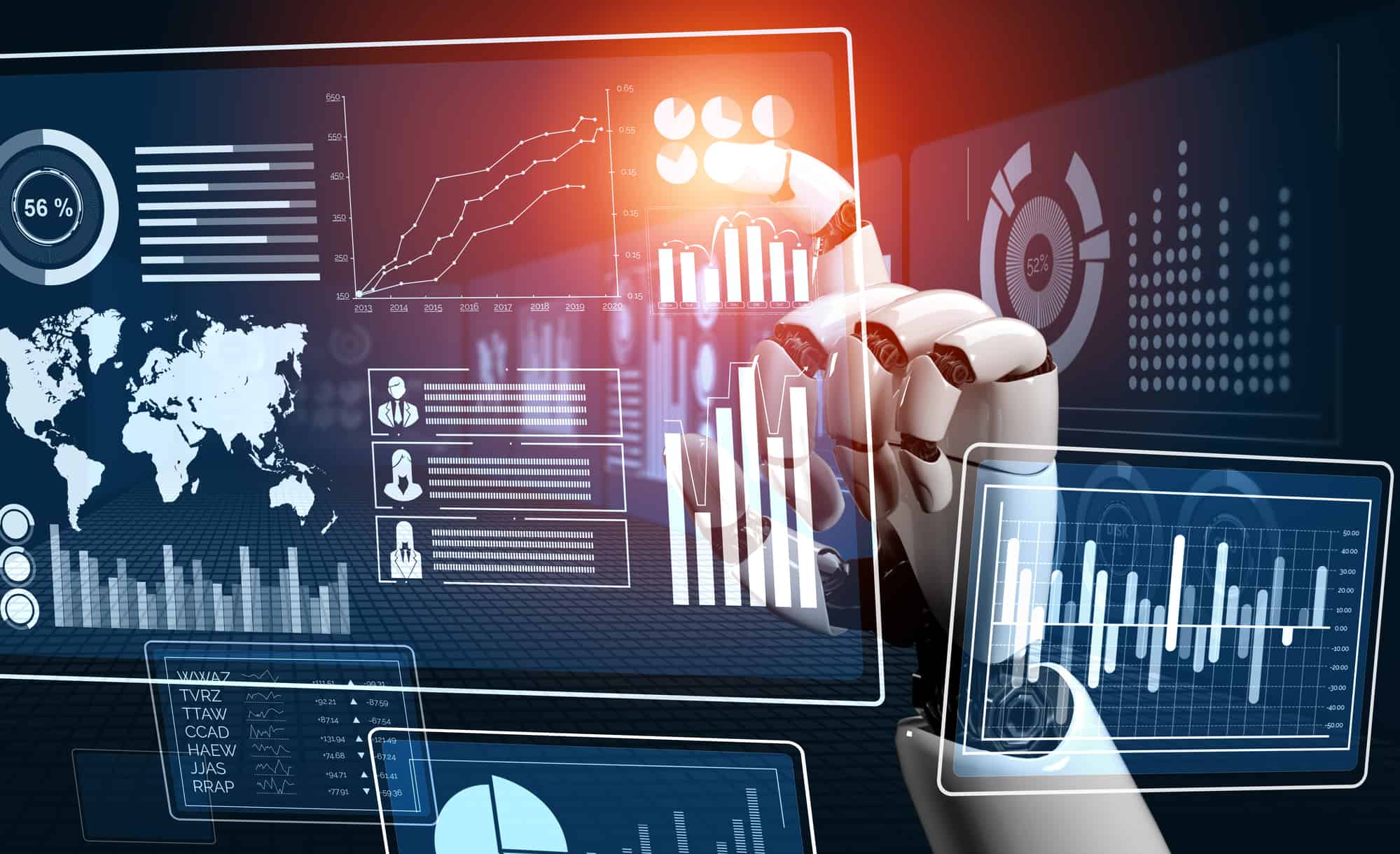Explore the synergy between data analysis techniques in machine learning and how machine learning data analysis transforms raw data into insights.
Picture this: you are working in a hospital where patient data is spread across electronic health records. Despite having all the lab reports and all the data, you won't be able to extract any useful information from it.
Now, imagine you can access predictive analytics models that use machine learning algorithms to analyze healthcare data. The machine learning models will not only sort the entire data but also identify the patterns within the data and the correlation between the early stages of diseases.
This scenario shows how important untapped data is and what difference it can make to tap the untapped data with the help of machine learning models. Untapping the data could help you predict and diagnose diseases early.
By doing machine learning data analysis, it can be possible to save millions of people's lives and reform healthcare facilities' operations.

Combining machine learning with data analysis
Machine learning is a form of Artificial Intelligence that develops algorithms that allow computers to learn from the data without programming. The purpose of machine learning is to improve the performance of current systems as they are exposed to more data.
On the other hand, data analysis is the process to analyse data to draw conclusive results. Data analysis helps us to extract useful information from the raw data. Both machine learning and data analysis hold great significance, and they are very useful.
However, when machine learning and data analysis combine, hidden potential in large datasets is unleashed. Due to the unleashed information, organisations and individuals can make well-informed decisions.
Combining machine learning and data analysis helps develop predictive models that predict future outcomes based on historical data.
Furthermore, the combination of the two also helps in cleaning data. Machine learning algorithms are sensitive to the quality of inputs. Hence, data analysis helps in identifying outliers and handling the missing values.
Besides that, machine learning and data analysis can help make new discoveries. Machine learning has the potential to identify hidden trends in the data and highlight subtle correlations. These characteristics of machine learning contribute to innovative solutions.
Whereas data analysis helps explore datasets in great detail, which helps identify the relationships between variables and solve problems.
What is Data Analysis in Machine Learning Context?
Data analysis is the art of transforming raw data into actionable insights through a meticulous process of extraction, cleaning, transformation, and modeling.
It's about digging deep into the data to uncover valuable information that lies hidden beneath the surface, ready to inform decision-making. By refining and organizing data, this process reveals patterns and trends that are crucial for making evidence-based decisions.
The insights gained from data analysis enable individuals and organizations to strategize and act with confidence, backed by data-driven evidence. Ultimately, data analysis turns the vast seas of raw data into a guiding light for informed decision-making, driving progress and innovation across various fields.
There are various data analysis methods, and each technique has its own significance. Let's proceed further and discuss some of the data analysis techniques.
Descriptive Statistics
Descriptive statistics of a dataset provide its main features. Descriptive statistics provides insight into a dataset by highlighting its mean, median, mode, range, shape, dispersion, etc. Descriptive statistics gives a quick overview of a dataset.
Inferential Statistics
Inferential statistics draws conclusions about the entire population based on a dataset. Different techniques, such as hypothesis testing, regression analysis, and confidence intervals, are used to make generalisations and predictions from a small data set.
Regression Analysis
Regression analysis is a technique to investigate the relationship between dependent and independent variables. Regression analysis tests the nature of relationships and predicts future outcomes.
Benefits of data analysis techniques
These data analysis techniques are essential since they provide foundations for effective machine learning models. To apply machine learning models, it is essential to have knowledge of data analysis.
Data analysis explores the characteristics of a dataset. It helps identify targeted variables and handle the missing values. Moreover, data analysis helps in identifying outliers in the dataset.
Besides that, data analysis techniques help transform variables. Scaling, encoding, and normalisation help ensure variables are in the appropriate format for machine learning algorithms.
Data analysis also identifies imbalances and uses techniques such as oversampling and undersampling to ensure model fairness.
Datasets have latent patterns; however, they are hard to identify. Combining data analysis and machine learning helps unleash the hidden information within the datasets.
The hidden trends and information provide a deeper insight into the variables' relationships, leading to better decision-making. Besides that, latent patterns help in the development of predictive models.

Machine Learning Algorithms for Data Analysis
Machine learning is linked to artificial intelligence. Machine learning aims to create algorithms that make predictions without being programmed. Moreover, another objective of machine learning is to create algorithms capable of learning patterns.
The fundamental principles of machine learning include learning from the data. The algorithms of machine learning are trained to learn from the data. The algorithms are exposed to data from which it generalises trends and patterns.
There are different types of learning. One type is supervised learning. Supervised learning refers to the learning where the algorithm is trained on the labelled data. The main objective of supervised learning is to learn a mapping from inputs to corresponding outputs.
Besides that, there is another type of learning called the unsupervised learning. In unsupervised learning, data is explored without labelled outcomes. The algorithm's job is to identify relationships and trends on its own.
Another type of learning is the reinforcement learning. In reinforcement learning, the algorithm is trained using a trial-and-error method. The algorithm is exposed to the environment and receives feedback through rewards and penalties.
Machine learning algorithms are essential to uncover a dataset's hidden patterns and trends. Let's look at specific machine learning algorithms highlighting the hidden trends.
1. Classification
Classification algorithms assign labels to input data based on patterns the algorithm has learned during training. The classification algorithm is used in email spam detection, face recognition, and sentiment analysis.
2. Regression
Regression algorithms predict numerical values based on input features. The regression algorithm predicts future stock prices, demand forecasting, and housing price prediction.
3. Clustering
The cluster algorithm groups similar data points based on inherent structures or patterns. The clustering algorithm is applied to customer segmentation, image segmentation, and anomaly detection.
Feature engineering is a significant part of data analysis. It involves selecting, transforming, or creating input variables (features) to intensify the performance of machine learning models.
Feature engineering helps uncover the hidden patterns and unleash the underlying data by identifying which features are relevant to the target variable or outcome.
Analysts can capture the patterns in the data by focusing on the most informative features. Besides that, feature engineering techniques help streamline the dataset and reduce the number of features while retaining the essential information.
Machine Learning Data Analysis: Real-world Applications
Machine learning data analysis has created an impact in various industries by identifying the underlying patterns. The exhibition of the hidden information has helped different industries.
For example, machine learning models identify the subtle correlation between the early stages of diseases. Moreover, by analysing patient data, machine learning models predict the likelihood of diseases like cancer.
Early detection of diseases through machine learning algorithms helps in timely intervention, which is beneficial for the patient health-wise and financially. Healthcare providers use the insights provided by machine learning algorithms to design treatment plans.
Moreover, machine learning models help banks to detect fraud. Machine learning algorithms analyse transaction patterns and detect anomalies and fraudulent activities. By doing so, machine learning algorithms help in the early detection of fraud.
Banks use these machine learning algorithms to detect fraudulent activities in advance so that they can be made unsuccessful.
Other than that, machine learning algorithms help ensure the quality of products in the manufacturing industry. Machine learning algorithms analyse images and production data to detect damaged goods.
With the help of machine learning algorithms, product quality will increase, and the efficiency of the manufacturing process will increase. Manufacturers use machine learning algorithms to increase the efficiency of the manufacturing process.

Challenges And Considerations in Machine Learning for Data Analysis
Machine learning combined with data analysis is a stone tool to identify hidden patterns in the dataset. However, incorporating data analysis techniques in machine learning do create several challenges.
For example, incomplete or biased training data can create models that do not represent the accurate real-world population. To overcome this problem, it is essential to collect data from diverse datasets. Furthermore, biases need to be addressed in the training data.
Besides that, the problem of overfitting and underfitting also exists. The problem of overfitting arises when the model learns the training data so well that it starts capturing minor distortions. On the contrary, the problem of underfitting exists when the model is too simplistic.
Other than that, some ethical considerations are also to be considered before obtaining insights from the data. For example, collecting private data may breach the personal privacy of individuals.
To overcome this problem, obtaining consent from individuals before accessing their data is essential.
Furthermore, biases in the dataset can lead to distorted outcomes. Hence, testing the data for biases before training the model is essential.
Tools And Techniques
Several tools and techniques are used for conducting machine learning data analysis. Let's look at some of the famous machine learning data analysis tools.
1. Python And Its Libraries
Python is a programming language. The libraries within the Python ecosystem provide a robust platform for data analysis and machine learning. Seaborn is a data visualisation library within Python that provides a high-level interface for statistical graphics.
2. R
R is also a programming language that helps conduct data analysis and visualisation. Caret is a toolkit that helps in evaluating and building machine learning models in R. Moreover, ggplot2 is also a package that helps in visualising data in R.
3. Tableau
Tableau is a tool that visualises data. It is also famous for creating interactive dashboards for users.
Visualization tools hold great significance in data analysis and communicating the findings. Visualisation helps data scientists, decision-makers, and analysts to convey information, insights, and patterns.
Visualisation tools help increase understanding of the data. It helps explore complex datasets and identify trends, patterns, and relationships that are hard to find in the raw data.
Besides that, visualisation tools help detect anomalies in the data easily. Deviations can also be clearly seen if the data is visually represented.
Furthermore, data visualisation makes it easy for people with no technical background to understand what the data is representing.
Future Trends And Possibilities
Machine learning data analysis processes are upgrading daily as technological advancements occur. It is expected that in the future, machine learning data analysis will redefine how organisations extract information from the data.
Several technologies will shape the future of data analysis, and automated machine learning is one of those technologies. Automated machine learning is a process where the end-to-end process of applying machine learning is automated.
Automated machine learning will reduce the barriers to entry and speed up the model development process, enabling organisations to make timely decisions.
Besides that, AI-powered data quality management will shape the future of machine learning data analysis. AI will be used to maintain data quality through cleaning and enrichment processes.
The future advancements will impact various sectors. For example, automated machine learning will increase efficiency in the health sector and enable health facilities to detect diseases at earlier stages.
Other than that, AI-powered quality management will help businesses maintain the quality of their data to obtain accurate results from it.
Conclusion
Machine learning is the process to train algorithms on a particular dataset so that it can make predictions programming. Machine learning data analysis combines to uncover the hidden trends in the dataset.
Organisations and individuals need to analyse their data with machine learning data analysis to extract the hidden information, which can help make well-informed decisions.
Everything discussed in this article about the potential of combining data analysis and machine learning is just the tip of the iceberg. As we continue to explore, we will learn that machine learning data analysis can take us far ahead of what we have imagined.


